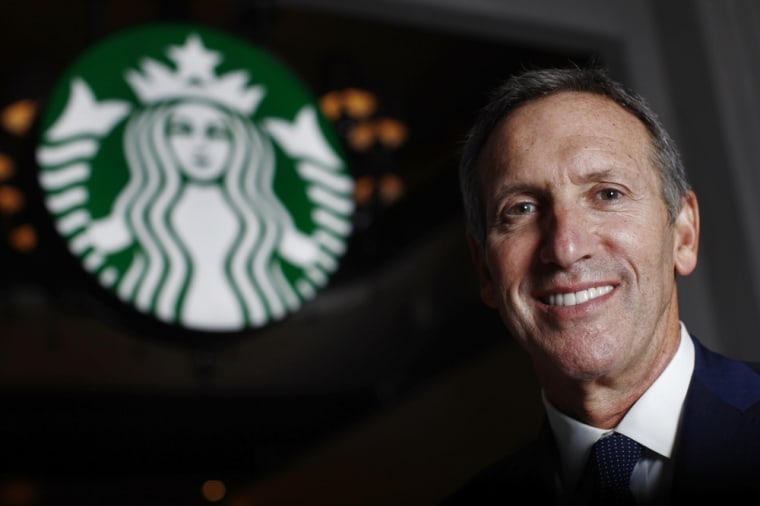Starbucks is expanding an unusual effort to create jobs through small business loans, which the company launched last fall after chief executive Howard Schultz lambasted politicians for not doing more to fix the economy.
So far the Create Jobs for USA program has raised about $11.5 million, including about $2.8 million from customers who bought brightly colored wristbands along with their lattes or donated to the program online.
Starbucks says its analysis shows the money raised so far could create or retain about 4,000 jobs.
While that is just a tiny fraction of the 12.7 million people who are unemployed and looking for work, Starbucks spokesman Jim Olson said the coffee giant has received mostly positive feedback from customers and that the program will continue indefinitely.
The program was launched in November, soon after Schultz publicly scolded politicians on both sides of the aisle for not doing more to deal with the country’s economic woes. Schultz also called on Americans to stop donating to politicians and asked business leaders to step up hiring to boost economic growth.
Despite billions of dollars in economic stimulus and record-low interest rates, the nation's unemployment rate remains painfully high at 8.2 percent.
Starbucks said Tuesday it plans to keep the focus on jobs by marketing a temporary line of mugs and other items to benefit the Create Jobs effort. It also announced that $1 million of the money raised so far had come from financial giant Citi and the bank’s foundation.
About $5 million in funding has come from the Starbucks Foundation, and the company also is covering the program’s administrative costs. The rest of the money has come from other business partners.
Experts say the program has likely helped small businesses and organizations in underserved communities get financing they might not have otherwise received. But they say it’s very tough to say how many jobs are created by such grass-roots efforts.
“Yeah, sure, there’s job (creation), but it’s really about making the community healthy,” said Julia Sass Rubin, an associate professor at Rutgers University’s Bloustein School of Planning and Public Policy and an expert on this type of lending.
The program works like this: When a customer buys a wristband or makes a donation, the money goes to the nonprofit Opportunity Finance Network. That organization passes the money on to community development financial institutions that in turn use the money toward loans in underserved areas to groups that might not qualify for a traditional bank loan.
Mark Pinksy, chief executive of Opportunity Finance Network, said lenders are required to use the donations to make loans and not for overhead costs. Starbucks said the $11.5 million in donations it has received so far can be leveraged to create up to $80 million in lending. Beneficiaries include a charter school, a community development corporation and a gelato store.
Pinsky said member institutions in the Opportunity Finance Network did more than $2 billion in total lending in 2010, the most recent data available.
The effort has attracted the attention of other big companies, such as Citi, the nation's No. 3 bank. Bob Annibale, global director of community development and microfinance for Citi, said the bank has long supported these financial institutions in other ways but that the Starbucks-founded program appealed in part because it is increasing awareness about the small loans.
Rubin, the professor, said there’s been more demand for such loans in part because big banks have been less willing to loan money to small businesses and organizations since the financial crisis that began in September 2008. Annibale said Citi also has tried to address the issue directly by increasing lending to small businesses. In 2011, he said, the company loaned about $7 billion to small businesses, up from $4.5 billion in 2009.
Citi also has cut tens of thousands of jobs in recent years, and in December announced plans to cut another 4,500 jobs. Annibale said employment is down partly because the company sold off some of its business.
Starbucks' latest effort will include the temporary “Indivisible” line of coffee beans, cups and mugs. The mugs are being made by a small factory in Ohio that received the type of small business loan the program supports, Olson said.
Starbucks itself has been adding jobs. The company employed 149,000 people as of October 2011, including 112,000 in the United States. That’s up from 137,000 as of October 2010, including 107,000 in the United States, according to the company’s annual reports.
Still, Starbucks employs fewer people than its 2008 peak of 176,000, including about 143,000 in the U.S. Starbucks was forced to close hundreds of stores and cut thousands of jobs as it grappled with the recession and other woes, although business has since rebounded.
Here is a look back at Schultz's battle cry last summer:
More from msnbc.com business:
